BUMGT5980 - Managerial Decision Making: Employee Disagreement Report
VerifiedAdded on 2022/12/20
|12
|3579
|44
Report
AI Summary
This report examines the problem of employee disagreement within an organization, focusing on the negative impacts on organizational performance and the spirit of brotherhood among employees. It provides a detailed background of the issue, highlighting factors like language barriers and ethnic...
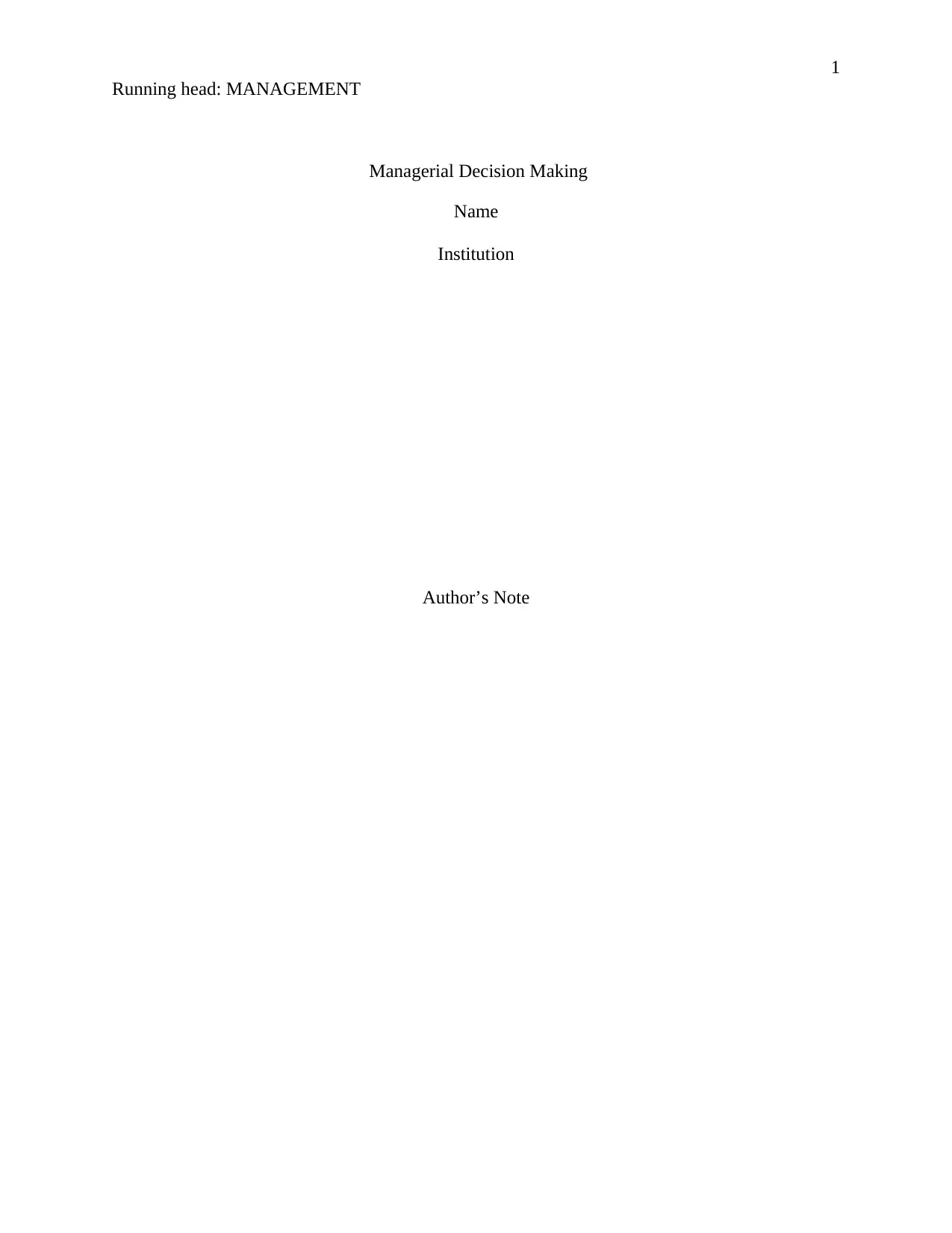
1
Running head: MANAGEMENT
Managerial Decision Making
Name
Institution
Author’s Note
Running head: MANAGEMENT
Managerial Decision Making
Name
Institution
Author’s Note
Paraphrase This Document
Need a fresh take? Get an instant paraphrase of this document with our AI Paraphraser
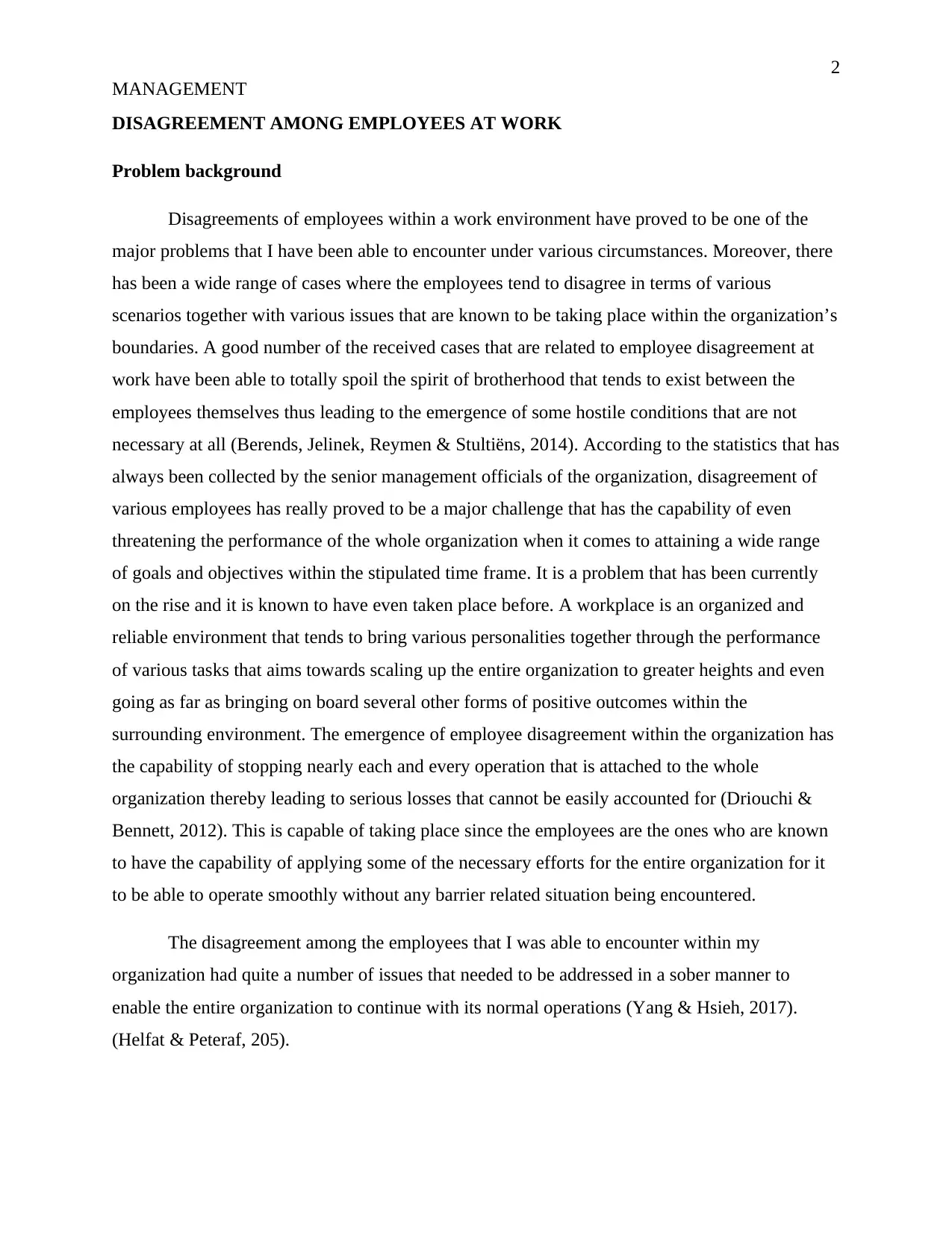
2
MANAGEMENT
DISAGREEMENT AMONG EMPLOYEES AT WORK
Problem background
Disagreements of employees within a work environment have proved to be one of the
major problems that I have been able to encounter under various circumstances. Moreover, there
has been a wide range of cases where the employees tend to disagree in terms of various
scenarios together with various issues that are known to be taking place within the organization’s
boundaries. A good number of the received cases that are related to employee disagreement at
work have been able to totally spoil the spirit of brotherhood that tends to exist between the
employees themselves thus leading to the emergence of some hostile conditions that are not
necessary at all (Berends, Jelinek, Reymen & Stultiëns, 2014). According to the statistics that has
always been collected by the senior management officials of the organization, disagreement of
various employees has really proved to be a major challenge that has the capability of even
threatening the performance of the whole organization when it comes to attaining a wide range
of goals and objectives within the stipulated time frame. It is a problem that has been currently
on the rise and it is known to have even taken place before. A workplace is an organized and
reliable environment that tends to bring various personalities together through the performance
of various tasks that aims towards scaling up the entire organization to greater heights and even
going as far as bringing on board several other forms of positive outcomes within the
surrounding environment. The emergence of employee disagreement within the organization has
the capability of stopping nearly each and every operation that is attached to the whole
organization thereby leading to serious losses that cannot be easily accounted for (Driouchi &
Bennett, 2012). This is capable of taking place since the employees are the ones who are known
to have the capability of applying some of the necessary efforts for the entire organization for it
to be able to operate smoothly without any barrier related situation being encountered.
The disagreement among the employees that I was able to encounter within my
organization had quite a number of issues that needed to be addressed in a sober manner to
enable the entire organization to continue with its normal operations (Yang & Hsieh, 2017).
(Helfat & Peteraf, 205).
MANAGEMENT
DISAGREEMENT AMONG EMPLOYEES AT WORK
Problem background
Disagreements of employees within a work environment have proved to be one of the
major problems that I have been able to encounter under various circumstances. Moreover, there
has been a wide range of cases where the employees tend to disagree in terms of various
scenarios together with various issues that are known to be taking place within the organization’s
boundaries. A good number of the received cases that are related to employee disagreement at
work have been able to totally spoil the spirit of brotherhood that tends to exist between the
employees themselves thus leading to the emergence of some hostile conditions that are not
necessary at all (Berends, Jelinek, Reymen & Stultiëns, 2014). According to the statistics that has
always been collected by the senior management officials of the organization, disagreement of
various employees has really proved to be a major challenge that has the capability of even
threatening the performance of the whole organization when it comes to attaining a wide range
of goals and objectives within the stipulated time frame. It is a problem that has been currently
on the rise and it is known to have even taken place before. A workplace is an organized and
reliable environment that tends to bring various personalities together through the performance
of various tasks that aims towards scaling up the entire organization to greater heights and even
going as far as bringing on board several other forms of positive outcomes within the
surrounding environment. The emergence of employee disagreement within the organization has
the capability of stopping nearly each and every operation that is attached to the whole
organization thereby leading to serious losses that cannot be easily accounted for (Driouchi &
Bennett, 2012). This is capable of taking place since the employees are the ones who are known
to have the capability of applying some of the necessary efforts for the entire organization for it
to be able to operate smoothly without any barrier related situation being encountered.
The disagreement among the employees that I was able to encounter within my
organization had quite a number of issues that needed to be addressed in a sober manner to
enable the entire organization to continue with its normal operations (Yang & Hsieh, 2017).
(Helfat & Peteraf, 205).
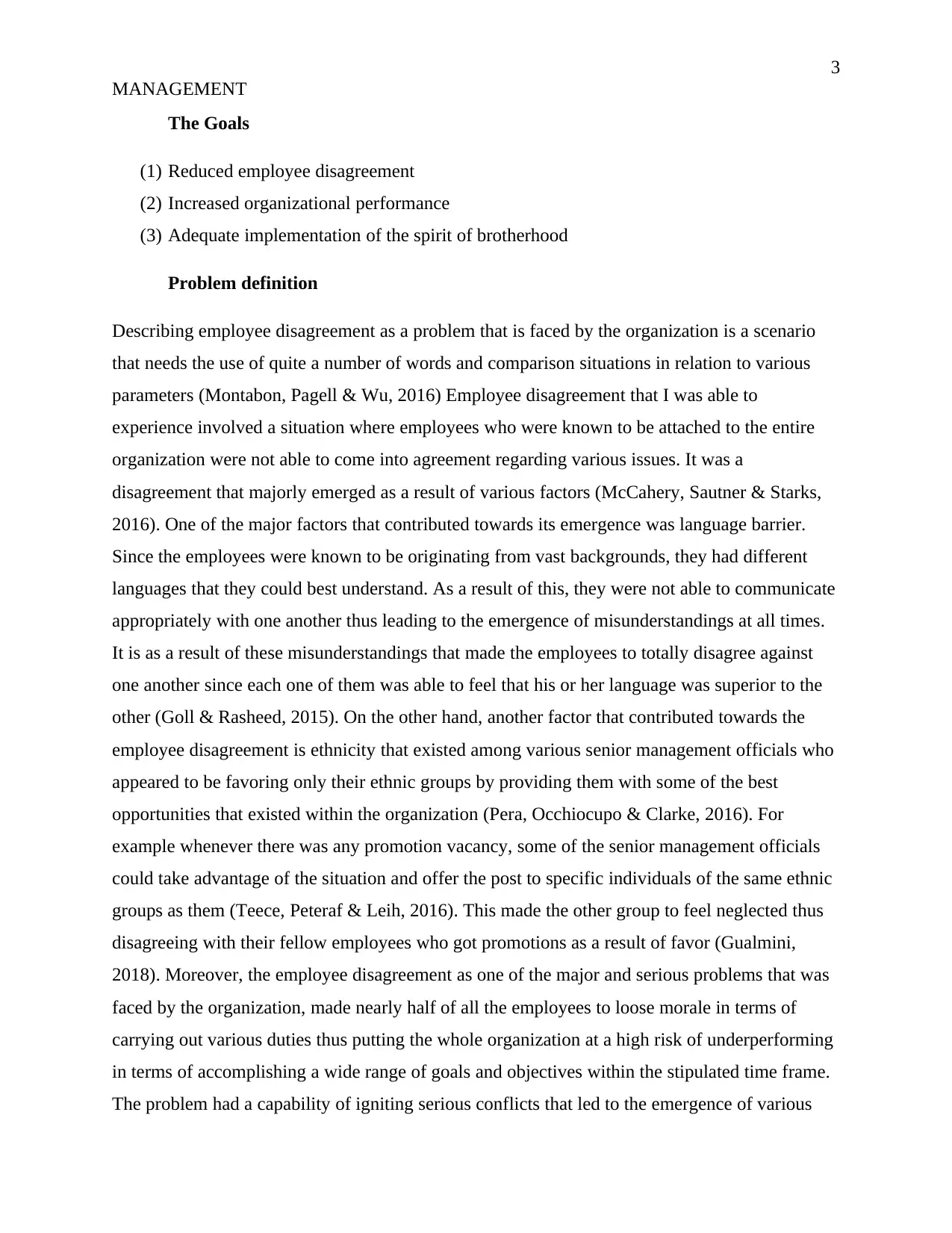
3
MANAGEMENT
The Goals
(1) Reduced employee disagreement
(2) Increased organizational performance
(3) Adequate implementation of the spirit of brotherhood
Problem definition
Describing employee disagreement as a problem that is faced by the organization is a scenario
that needs the use of quite a number of words and comparison situations in relation to various
parameters (Montabon, Pagell & Wu, 2016) Employee disagreement that I was able to
experience involved a situation where employees who were known to be attached to the entire
organization were not able to come into agreement regarding various issues. It was a
disagreement that majorly emerged as a result of various factors (McCahery, Sautner & Starks,
2016). One of the major factors that contributed towards its emergence was language barrier.
Since the employees were known to be originating from vast backgrounds, they had different
languages that they could best understand. As a result of this, they were not able to communicate
appropriately with one another thus leading to the emergence of misunderstandings at all times.
It is as a result of these misunderstandings that made the employees to totally disagree against
one another since each one of them was able to feel that his or her language was superior to the
other (Goll & Rasheed, 2015). On the other hand, another factor that contributed towards the
employee disagreement is ethnicity that existed among various senior management officials who
appeared to be favoring only their ethnic groups by providing them with some of the best
opportunities that existed within the organization (Pera, Occhiocupo & Clarke, 2016). For
example whenever there was any promotion vacancy, some of the senior management officials
could take advantage of the situation and offer the post to specific individuals of the same ethnic
groups as them (Teece, Peteraf & Leih, 2016). This made the other group to feel neglected thus
disagreeing with their fellow employees who got promotions as a result of favor (Gualmini,
2018). Moreover, the employee disagreement as one of the major and serious problems that was
faced by the organization, made nearly half of all the employees to loose morale in terms of
carrying out various duties thus putting the whole organization at a high risk of underperforming
in terms of accomplishing a wide range of goals and objectives within the stipulated time frame.
The problem had a capability of igniting serious conflicts that led to the emergence of various
MANAGEMENT
The Goals
(1) Reduced employee disagreement
(2) Increased organizational performance
(3) Adequate implementation of the spirit of brotherhood
Problem definition
Describing employee disagreement as a problem that is faced by the organization is a scenario
that needs the use of quite a number of words and comparison situations in relation to various
parameters (Montabon, Pagell & Wu, 2016) Employee disagreement that I was able to
experience involved a situation where employees who were known to be attached to the entire
organization were not able to come into agreement regarding various issues. It was a
disagreement that majorly emerged as a result of various factors (McCahery, Sautner & Starks,
2016). One of the major factors that contributed towards its emergence was language barrier.
Since the employees were known to be originating from vast backgrounds, they had different
languages that they could best understand. As a result of this, they were not able to communicate
appropriately with one another thus leading to the emergence of misunderstandings at all times.
It is as a result of these misunderstandings that made the employees to totally disagree against
one another since each one of them was able to feel that his or her language was superior to the
other (Goll & Rasheed, 2015). On the other hand, another factor that contributed towards the
employee disagreement is ethnicity that existed among various senior management officials who
appeared to be favoring only their ethnic groups by providing them with some of the best
opportunities that existed within the organization (Pera, Occhiocupo & Clarke, 2016). For
example whenever there was any promotion vacancy, some of the senior management officials
could take advantage of the situation and offer the post to specific individuals of the same ethnic
groups as them (Teece, Peteraf & Leih, 2016). This made the other group to feel neglected thus
disagreeing with their fellow employees who got promotions as a result of favor (Gualmini,
2018). Moreover, the employee disagreement as one of the major and serious problems that was
faced by the organization, made nearly half of all the employees to loose morale in terms of
carrying out various duties thus putting the whole organization at a high risk of underperforming
in terms of accomplishing a wide range of goals and objectives within the stipulated time frame.
The problem had a capability of igniting serious conflicts that led to the emergence of various
⊘ This is a preview!⊘
Do you want full access?
Subscribe today to unlock all pages.

Trusted by 1+ million students worldwide
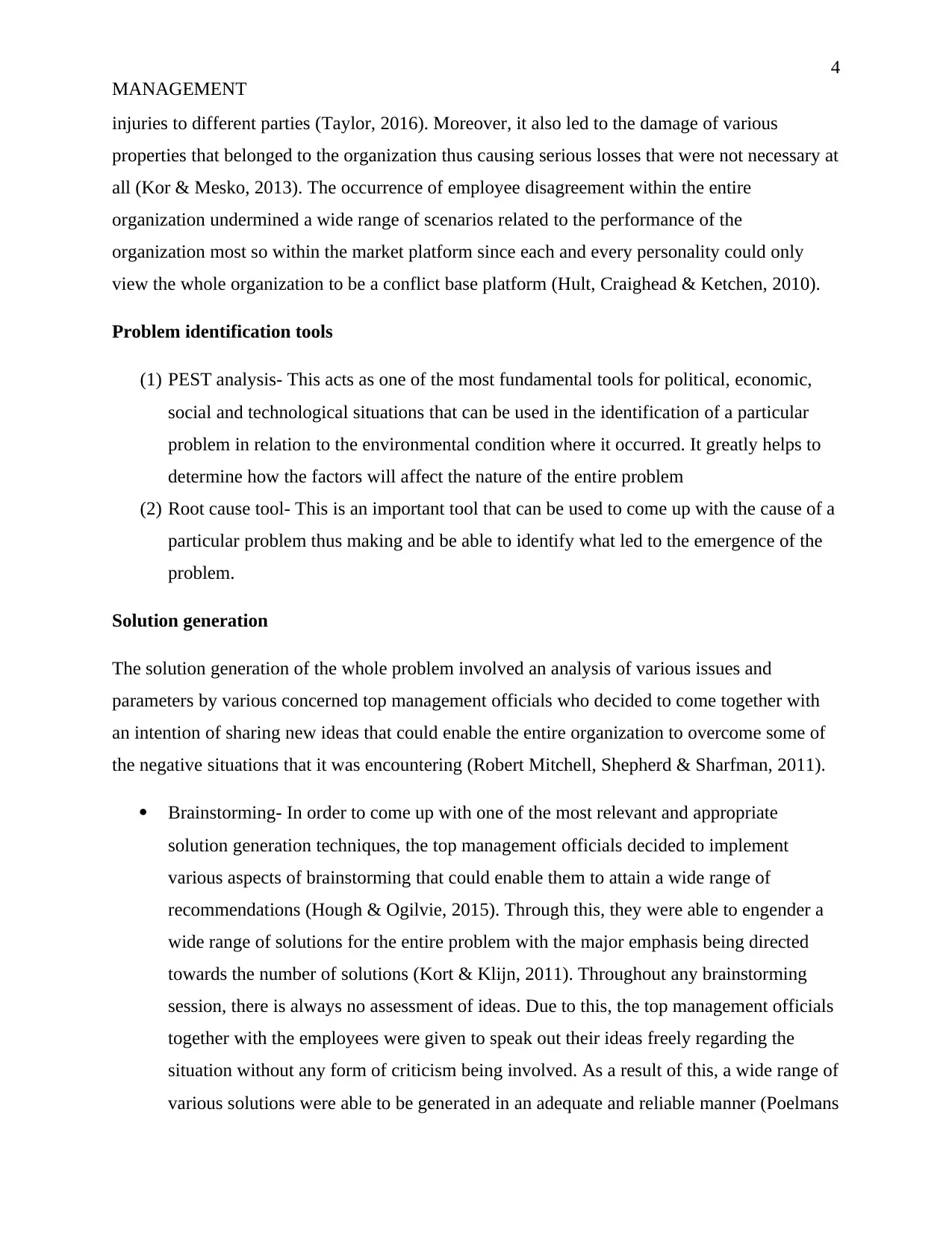
4
MANAGEMENT
injuries to different parties (Taylor, 2016). Moreover, it also led to the damage of various
properties that belonged to the organization thus causing serious losses that were not necessary at
all (Kor & Mesko, 2013). The occurrence of employee disagreement within the entire
organization undermined a wide range of scenarios related to the performance of the
organization most so within the market platform since each and every personality could only
view the whole organization to be a conflict base platform (Hult, Craighead & Ketchen, 2010).
Problem identification tools
(1) PEST analysis- This acts as one of the most fundamental tools for political, economic,
social and technological situations that can be used in the identification of a particular
problem in relation to the environmental condition where it occurred. It greatly helps to
determine how the factors will affect the nature of the entire problem
(2) Root cause tool- This is an important tool that can be used to come up with the cause of a
particular problem thus making and be able to identify what led to the emergence of the
problem.
Solution generation
The solution generation of the whole problem involved an analysis of various issues and
parameters by various concerned top management officials who decided to come together with
an intention of sharing new ideas that could enable the entire organization to overcome some of
the negative situations that it was encountering (Robert Mitchell, Shepherd & Sharfman, 2011).
Brainstorming- In order to come up with one of the most relevant and appropriate
solution generation techniques, the top management officials decided to implement
various aspects of brainstorming that could enable them to attain a wide range of
recommendations (Hough & Ogilvie, 2015). Through this, they were able to engender a
wide range of solutions for the entire problem with the major emphasis being directed
towards the number of solutions (Kort & Klijn, 2011). Throughout any brainstorming
session, there is always no assessment of ideas. Due to this, the top management officials
together with the employees were given to speak out their ideas freely regarding the
situation without any form of criticism being involved. As a result of this, a wide range of
various solutions were able to be generated in an adequate and reliable manner (Poelmans
MANAGEMENT
injuries to different parties (Taylor, 2016). Moreover, it also led to the damage of various
properties that belonged to the organization thus causing serious losses that were not necessary at
all (Kor & Mesko, 2013). The occurrence of employee disagreement within the entire
organization undermined a wide range of scenarios related to the performance of the
organization most so within the market platform since each and every personality could only
view the whole organization to be a conflict base platform (Hult, Craighead & Ketchen, 2010).
Problem identification tools
(1) PEST analysis- This acts as one of the most fundamental tools for political, economic,
social and technological situations that can be used in the identification of a particular
problem in relation to the environmental condition where it occurred. It greatly helps to
determine how the factors will affect the nature of the entire problem
(2) Root cause tool- This is an important tool that can be used to come up with the cause of a
particular problem thus making and be able to identify what led to the emergence of the
problem.
Solution generation
The solution generation of the whole problem involved an analysis of various issues and
parameters by various concerned top management officials who decided to come together with
an intention of sharing new ideas that could enable the entire organization to overcome some of
the negative situations that it was encountering (Robert Mitchell, Shepherd & Sharfman, 2011).
Brainstorming- In order to come up with one of the most relevant and appropriate
solution generation techniques, the top management officials decided to implement
various aspects of brainstorming that could enable them to attain a wide range of
recommendations (Hough & Ogilvie, 2015). Through this, they were able to engender a
wide range of solutions for the entire problem with the major emphasis being directed
towards the number of solutions (Kort & Klijn, 2011). Throughout any brainstorming
session, there is always no assessment of ideas. Due to this, the top management officials
together with the employees were given to speak out their ideas freely regarding the
situation without any form of criticism being involved. As a result of this, a wide range of
various solutions were able to be generated in an adequate and reliable manner (Poelmans
Paraphrase This Document
Need a fresh take? Get an instant paraphrase of this document with our AI Paraphraser
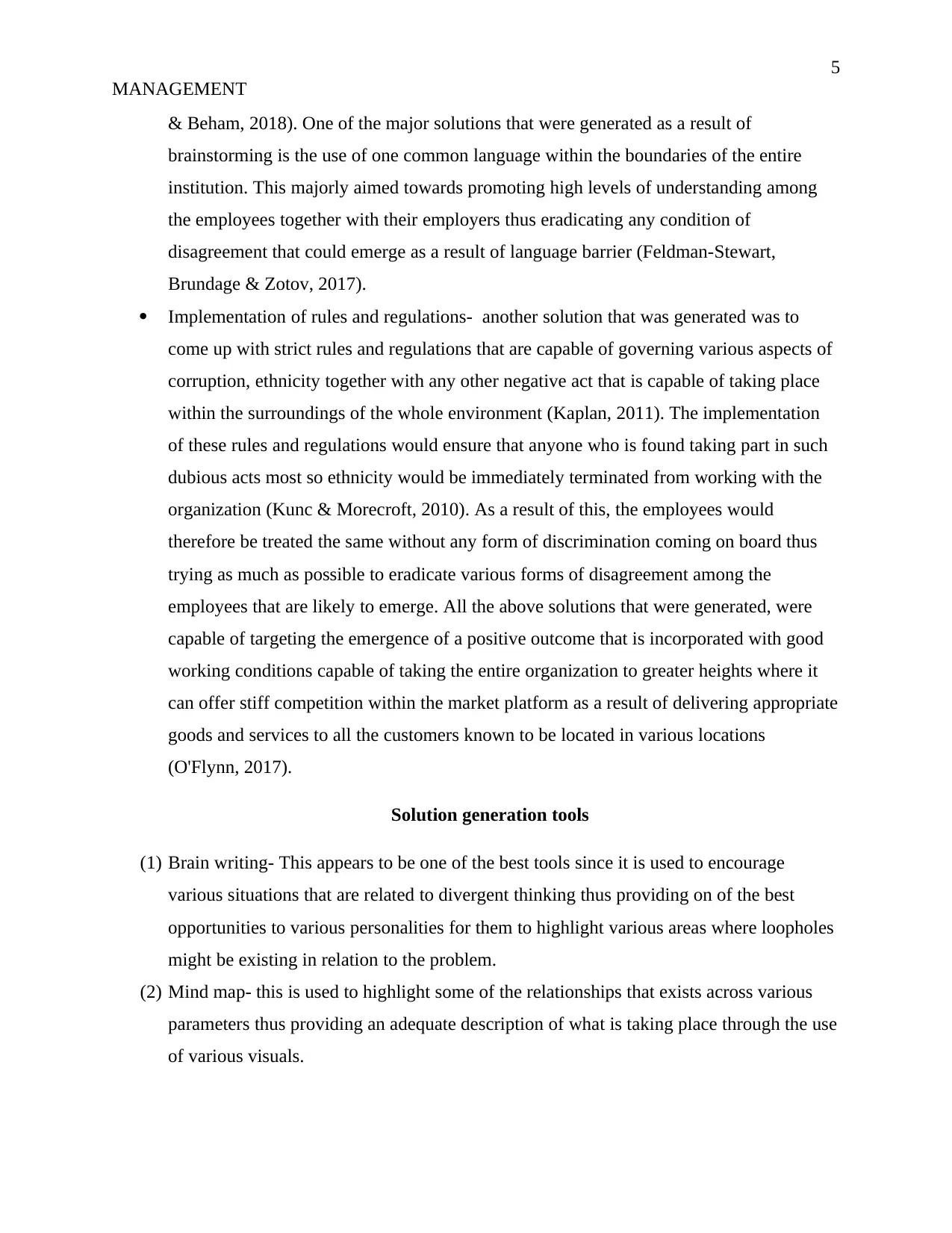
5
MANAGEMENT
& Beham, 2018). One of the major solutions that were generated as a result of
brainstorming is the use of one common language within the boundaries of the entire
institution. This majorly aimed towards promoting high levels of understanding among
the employees together with their employers thus eradicating any condition of
disagreement that could emerge as a result of language barrier (Feldman-Stewart,
Brundage & Zotov, 2017).
Implementation of rules and regulations- another solution that was generated was to
come up with strict rules and regulations that are capable of governing various aspects of
corruption, ethnicity together with any other negative act that is capable of taking place
within the surroundings of the whole environment (Kaplan, 2011). The implementation
of these rules and regulations would ensure that anyone who is found taking part in such
dubious acts most so ethnicity would be immediately terminated from working with the
organization (Kunc & Morecroft, 2010). As a result of this, the employees would
therefore be treated the same without any form of discrimination coming on board thus
trying as much as possible to eradicate various forms of disagreement among the
employees that are likely to emerge. All the above solutions that were generated, were
capable of targeting the emergence of a positive outcome that is incorporated with good
working conditions capable of taking the entire organization to greater heights where it
can offer stiff competition within the market platform as a result of delivering appropriate
goods and services to all the customers known to be located in various locations
(O'Flynn, 2017).
Solution generation tools
(1) Brain writing- This appears to be one of the best tools since it is used to encourage
various situations that are related to divergent thinking thus providing on of the best
opportunities to various personalities for them to highlight various areas where loopholes
might be existing in relation to the problem.
(2) Mind map- this is used to highlight some of the relationships that exists across various
parameters thus providing an adequate description of what is taking place through the use
of various visuals.
MANAGEMENT
& Beham, 2018). One of the major solutions that were generated as a result of
brainstorming is the use of one common language within the boundaries of the entire
institution. This majorly aimed towards promoting high levels of understanding among
the employees together with their employers thus eradicating any condition of
disagreement that could emerge as a result of language barrier (Feldman-Stewart,
Brundage & Zotov, 2017).
Implementation of rules and regulations- another solution that was generated was to
come up with strict rules and regulations that are capable of governing various aspects of
corruption, ethnicity together with any other negative act that is capable of taking place
within the surroundings of the whole environment (Kaplan, 2011). The implementation
of these rules and regulations would ensure that anyone who is found taking part in such
dubious acts most so ethnicity would be immediately terminated from working with the
organization (Kunc & Morecroft, 2010). As a result of this, the employees would
therefore be treated the same without any form of discrimination coming on board thus
trying as much as possible to eradicate various forms of disagreement among the
employees that are likely to emerge. All the above solutions that were generated, were
capable of targeting the emergence of a positive outcome that is incorporated with good
working conditions capable of taking the entire organization to greater heights where it
can offer stiff competition within the market platform as a result of delivering appropriate
goods and services to all the customers known to be located in various locations
(O'Flynn, 2017).
Solution generation tools
(1) Brain writing- This appears to be one of the best tools since it is used to encourage
various situations that are related to divergent thinking thus providing on of the best
opportunities to various personalities for them to highlight various areas where loopholes
might be existing in relation to the problem.
(2) Mind map- this is used to highlight some of the relationships that exists across various
parameters thus providing an adequate description of what is taking place through the use
of various visuals.
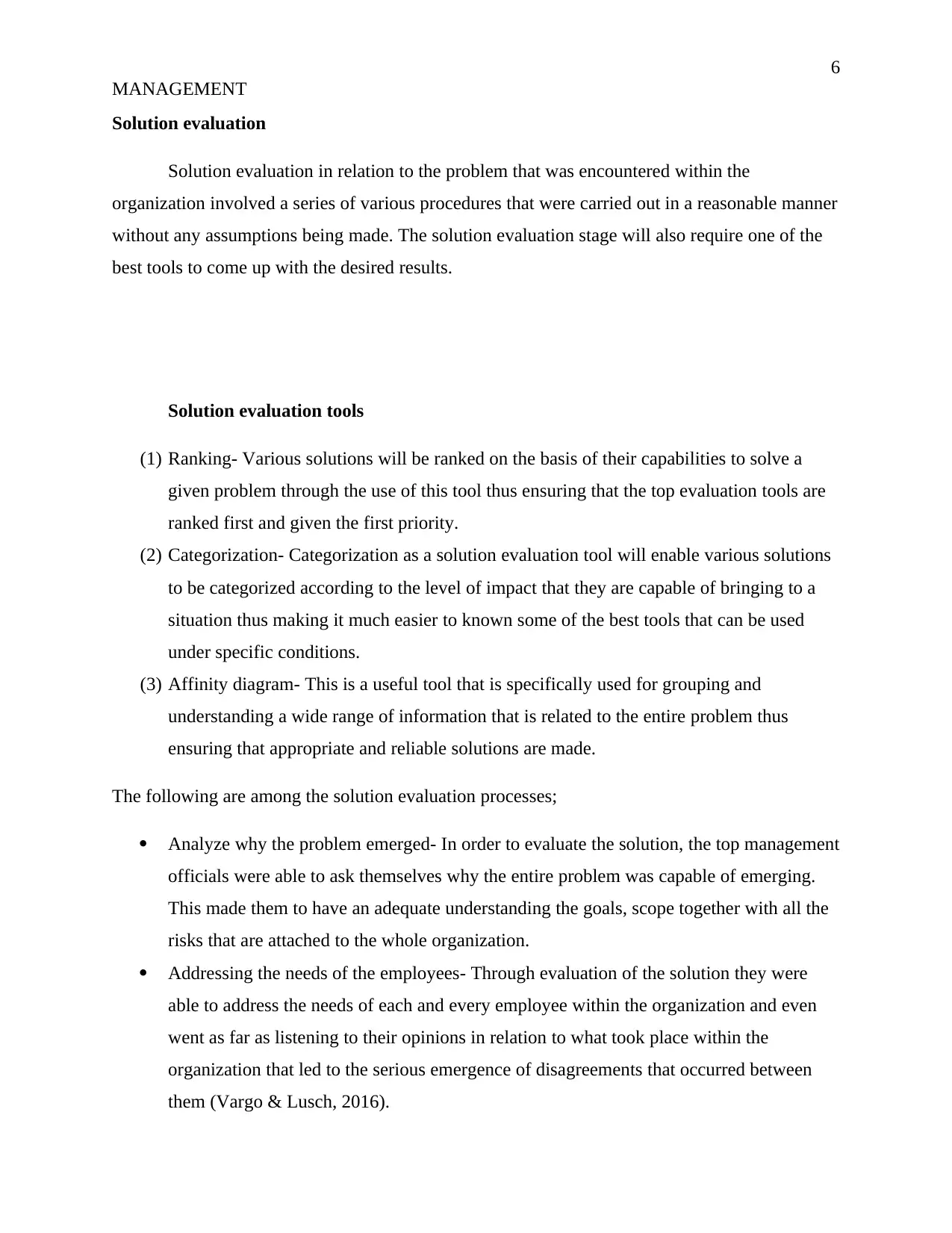
6
MANAGEMENT
Solution evaluation
Solution evaluation in relation to the problem that was encountered within the
organization involved a series of various procedures that were carried out in a reasonable manner
without any assumptions being made. The solution evaluation stage will also require one of the
best tools to come up with the desired results.
Solution evaluation tools
(1) Ranking- Various solutions will be ranked on the basis of their capabilities to solve a
given problem through the use of this tool thus ensuring that the top evaluation tools are
ranked first and given the first priority.
(2) Categorization- Categorization as a solution evaluation tool will enable various solutions
to be categorized according to the level of impact that they are capable of bringing to a
situation thus making it much easier to known some of the best tools that can be used
under specific conditions.
(3) Affinity diagram- This is a useful tool that is specifically used for grouping and
understanding a wide range of information that is related to the entire problem thus
ensuring that appropriate and reliable solutions are made.
The following are among the solution evaluation processes;
Analyze why the problem emerged- In order to evaluate the solution, the top management
officials were able to ask themselves why the entire problem was capable of emerging.
This made them to have an adequate understanding the goals, scope together with all the
risks that are attached to the whole organization.
Addressing the needs of the employees- Through evaluation of the solution they were
able to address the needs of each and every employee within the organization and even
went as far as listening to their opinions in relation to what took place within the
organization that led to the serious emergence of disagreements that occurred between
them (Vargo & Lusch, 2016).
MANAGEMENT
Solution evaluation
Solution evaluation in relation to the problem that was encountered within the
organization involved a series of various procedures that were carried out in a reasonable manner
without any assumptions being made. The solution evaluation stage will also require one of the
best tools to come up with the desired results.
Solution evaluation tools
(1) Ranking- Various solutions will be ranked on the basis of their capabilities to solve a
given problem through the use of this tool thus ensuring that the top evaluation tools are
ranked first and given the first priority.
(2) Categorization- Categorization as a solution evaluation tool will enable various solutions
to be categorized according to the level of impact that they are capable of bringing to a
situation thus making it much easier to known some of the best tools that can be used
under specific conditions.
(3) Affinity diagram- This is a useful tool that is specifically used for grouping and
understanding a wide range of information that is related to the entire problem thus
ensuring that appropriate and reliable solutions are made.
The following are among the solution evaluation processes;
Analyze why the problem emerged- In order to evaluate the solution, the top management
officials were able to ask themselves why the entire problem was capable of emerging.
This made them to have an adequate understanding the goals, scope together with all the
risks that are attached to the whole organization.
Addressing the needs of the employees- Through evaluation of the solution they were
able to address the needs of each and every employee within the organization and even
went as far as listening to their opinions in relation to what took place within the
organization that led to the serious emergence of disagreements that occurred between
them (Vargo & Lusch, 2016).
⊘ This is a preview!⊘
Do you want full access?
Subscribe today to unlock all pages.

Trusted by 1+ million students worldwide
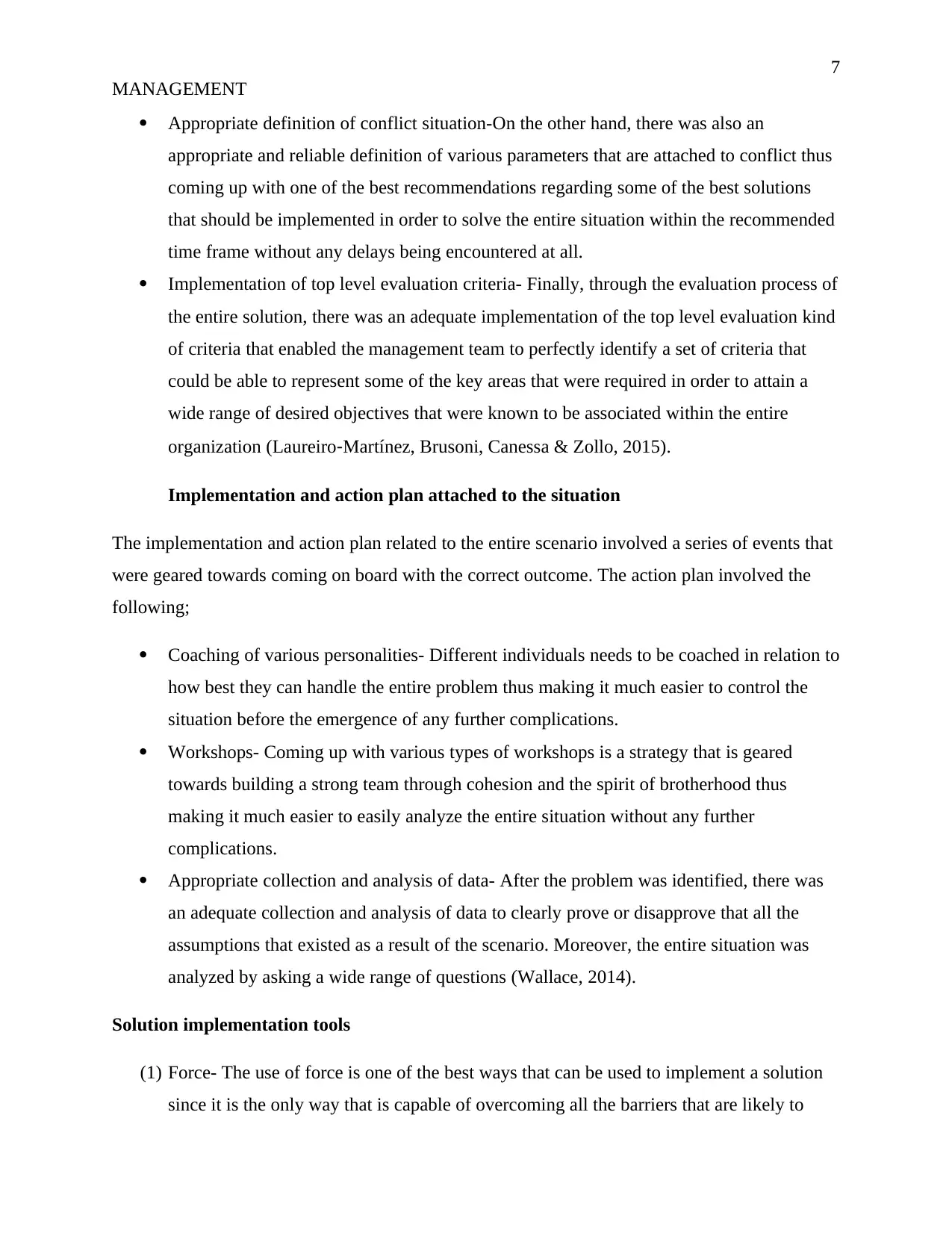
7
MANAGEMENT
Appropriate definition of conflict situation-On the other hand, there was also an
appropriate and reliable definition of various parameters that are attached to conflict thus
coming up with one of the best recommendations regarding some of the best solutions
that should be implemented in order to solve the entire situation within the recommended
time frame without any delays being encountered at all.
Implementation of top level evaluation criteria- Finally, through the evaluation process of
the entire solution, there was an adequate implementation of the top level evaluation kind
of criteria that enabled the management team to perfectly identify a set of criteria that
could be able to represent some of the key areas that were required in order to attain a
wide range of desired objectives that were known to be associated within the entire
organization (Laureiro‐Martínez, Brusoni, Canessa & Zollo, 2015).
Implementation and action plan attached to the situation
The implementation and action plan related to the entire scenario involved a series of events that
were geared towards coming on board with the correct outcome. The action plan involved the
following;
Coaching of various personalities- Different individuals needs to be coached in relation to
how best they can handle the entire problem thus making it much easier to control the
situation before the emergence of any further complications.
Workshops- Coming up with various types of workshops is a strategy that is geared
towards building a strong team through cohesion and the spirit of brotherhood thus
making it much easier to easily analyze the entire situation without any further
complications.
Appropriate collection and analysis of data- After the problem was identified, there was
an adequate collection and analysis of data to clearly prove or disapprove that all the
assumptions that existed as a result of the scenario. Moreover, the entire situation was
analyzed by asking a wide range of questions (Wallace, 2014).
Solution implementation tools
(1) Force- The use of force is one of the best ways that can be used to implement a solution
since it is the only way that is capable of overcoming all the barriers that are likely to
MANAGEMENT
Appropriate definition of conflict situation-On the other hand, there was also an
appropriate and reliable definition of various parameters that are attached to conflict thus
coming up with one of the best recommendations regarding some of the best solutions
that should be implemented in order to solve the entire situation within the recommended
time frame without any delays being encountered at all.
Implementation of top level evaluation criteria- Finally, through the evaluation process of
the entire solution, there was an adequate implementation of the top level evaluation kind
of criteria that enabled the management team to perfectly identify a set of criteria that
could be able to represent some of the key areas that were required in order to attain a
wide range of desired objectives that were known to be associated within the entire
organization (Laureiro‐Martínez, Brusoni, Canessa & Zollo, 2015).
Implementation and action plan attached to the situation
The implementation and action plan related to the entire scenario involved a series of events that
were geared towards coming on board with the correct outcome. The action plan involved the
following;
Coaching of various personalities- Different individuals needs to be coached in relation to
how best they can handle the entire problem thus making it much easier to control the
situation before the emergence of any further complications.
Workshops- Coming up with various types of workshops is a strategy that is geared
towards building a strong team through cohesion and the spirit of brotherhood thus
making it much easier to easily analyze the entire situation without any further
complications.
Appropriate collection and analysis of data- After the problem was identified, there was
an adequate collection and analysis of data to clearly prove or disapprove that all the
assumptions that existed as a result of the scenario. Moreover, the entire situation was
analyzed by asking a wide range of questions (Wallace, 2014).
Solution implementation tools
(1) Force- The use of force is one of the best ways that can be used to implement a solution
since it is the only way that is capable of overcoming all the barriers that are likely to
Paraphrase This Document
Need a fresh take? Get an instant paraphrase of this document with our AI Paraphraser

8
MANAGEMENT
prevent the positive outcomes capable of emerging as a result of the solution
implementation.
(2) Analysis- This tool will help various personalities to adequately analyze various
situations that are attached to a given solution thus making it much easier for its
implementation to take place.
Conclusion
The entire problem that occurred within the organization was able to cause serious threats
thus hindering its performance within various platforms. Appropriate implementation of various
adequate and reliable strategies is what helped the organization to come back to its original
position and be able to offer a stiff competition the way it used to do initially. Moreover, the
ability of the top management team to accept that in deed there was a problem, greatly facilitated
the emergence of a wide range of recommendations through the implementation of a wide range
of problem definition techniques together with solution generation techniques that were able to
provide the correct direction that needed to be followed in order to fully solve the whole problem
that was encountered by the employees as a result of various factors. Moreover, they were also
able to implement a wide range of ethical strategies that were able to offer appropriate and
reliable guidance on what should be done together with what should be avoided in order to attain
some of the best outcomes.
MANAGEMENT
prevent the positive outcomes capable of emerging as a result of the solution
implementation.
(2) Analysis- This tool will help various personalities to adequately analyze various
situations that are attached to a given solution thus making it much easier for its
implementation to take place.
Conclusion
The entire problem that occurred within the organization was able to cause serious threats
thus hindering its performance within various platforms. Appropriate implementation of various
adequate and reliable strategies is what helped the organization to come back to its original
position and be able to offer a stiff competition the way it used to do initially. Moreover, the
ability of the top management team to accept that in deed there was a problem, greatly facilitated
the emergence of a wide range of recommendations through the implementation of a wide range
of problem definition techniques together with solution generation techniques that were able to
provide the correct direction that needed to be followed in order to fully solve the whole problem
that was encountered by the employees as a result of various factors. Moreover, they were also
able to implement a wide range of ethical strategies that were able to offer appropriate and
reliable guidance on what should be done together with what should be avoided in order to attain
some of the best outcomes.
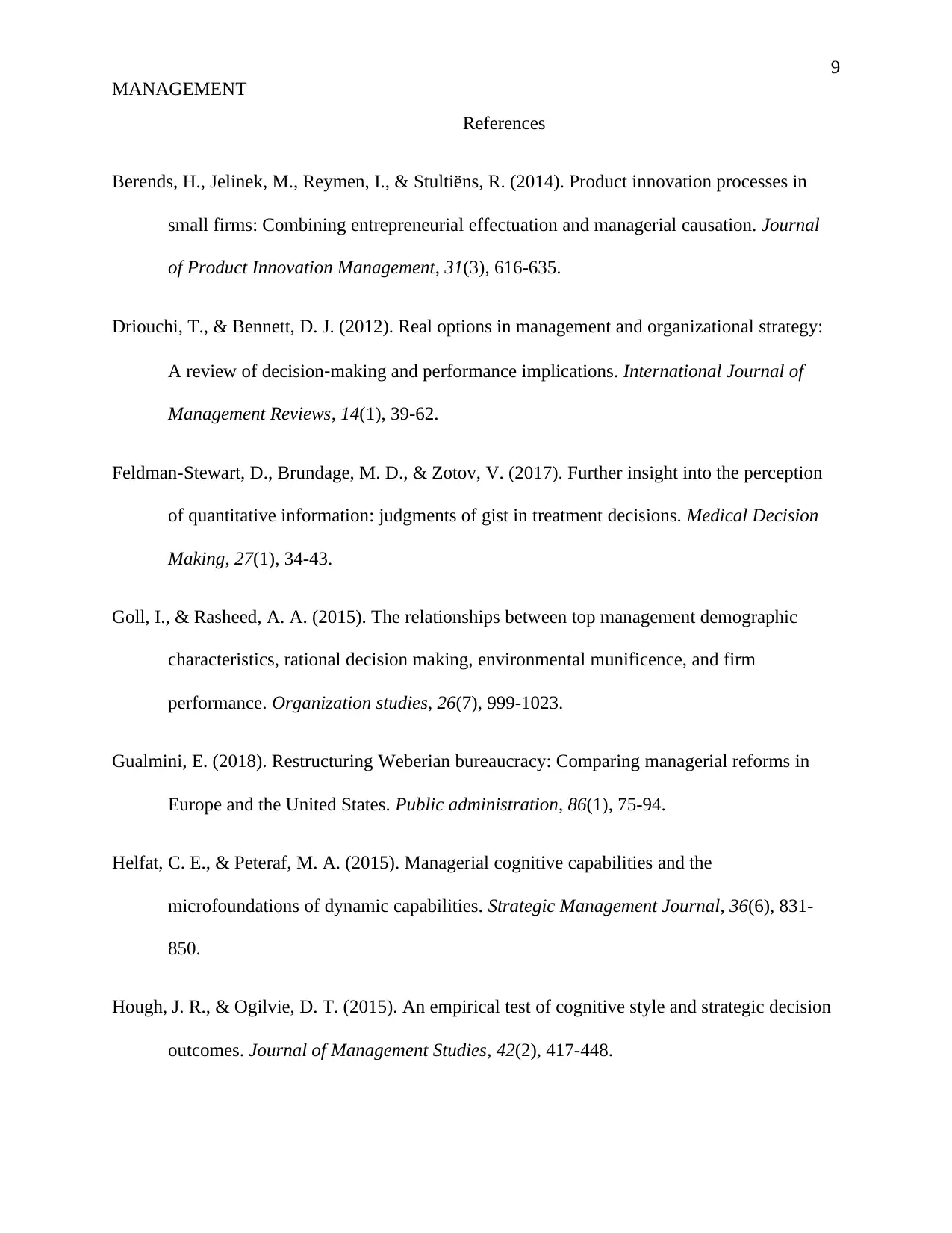
9
MANAGEMENT
References
Berends, H., Jelinek, M., Reymen, I., & Stultiëns, R. (2014). Product innovation processes in
small firms: Combining entrepreneurial effectuation and managerial causation. Journal
of Product Innovation Management, 31(3), 616-635.
Driouchi, T., & Bennett, D. J. (2012). Real options in management and organizational strategy:
A review of decision‐making and performance implications. International Journal of
Management Reviews, 14(1), 39-62.
Feldman-Stewart, D., Brundage, M. D., & Zotov, V. (2017). Further insight into the perception
of quantitative information: judgments of gist in treatment decisions. Medical Decision
Making, 27(1), 34-43.
Goll, I., & Rasheed, A. A. (2015). The relationships between top management demographic
characteristics, rational decision making, environmental munificence, and firm
performance. Organization studies, 26(7), 999-1023.
Gualmini, E. (2018). Restructuring Weberian bureaucracy: Comparing managerial reforms in
Europe and the United States. Public administration, 86(1), 75-94.
Helfat, C. E., & Peteraf, M. A. (2015). Managerial cognitive capabilities and the
microfoundations of dynamic capabilities. Strategic Management Journal, 36(6), 831-
850.
Hough, J. R., & Ogilvie, D. T. (2015). An empirical test of cognitive style and strategic decision
outcomes. Journal of Management Studies, 42(2), 417-448.
MANAGEMENT
References
Berends, H., Jelinek, M., Reymen, I., & Stultiëns, R. (2014). Product innovation processes in
small firms: Combining entrepreneurial effectuation and managerial causation. Journal
of Product Innovation Management, 31(3), 616-635.
Driouchi, T., & Bennett, D. J. (2012). Real options in management and organizational strategy:
A review of decision‐making and performance implications. International Journal of
Management Reviews, 14(1), 39-62.
Feldman-Stewart, D., Brundage, M. D., & Zotov, V. (2017). Further insight into the perception
of quantitative information: judgments of gist in treatment decisions. Medical Decision
Making, 27(1), 34-43.
Goll, I., & Rasheed, A. A. (2015). The relationships between top management demographic
characteristics, rational decision making, environmental munificence, and firm
performance. Organization studies, 26(7), 999-1023.
Gualmini, E. (2018). Restructuring Weberian bureaucracy: Comparing managerial reforms in
Europe and the United States. Public administration, 86(1), 75-94.
Helfat, C. E., & Peteraf, M. A. (2015). Managerial cognitive capabilities and the
microfoundations of dynamic capabilities. Strategic Management Journal, 36(6), 831-
850.
Hough, J. R., & Ogilvie, D. T. (2015). An empirical test of cognitive style and strategic decision
outcomes. Journal of Management Studies, 42(2), 417-448.
⊘ This is a preview!⊘
Do you want full access?
Subscribe today to unlock all pages.

Trusted by 1+ million students worldwide
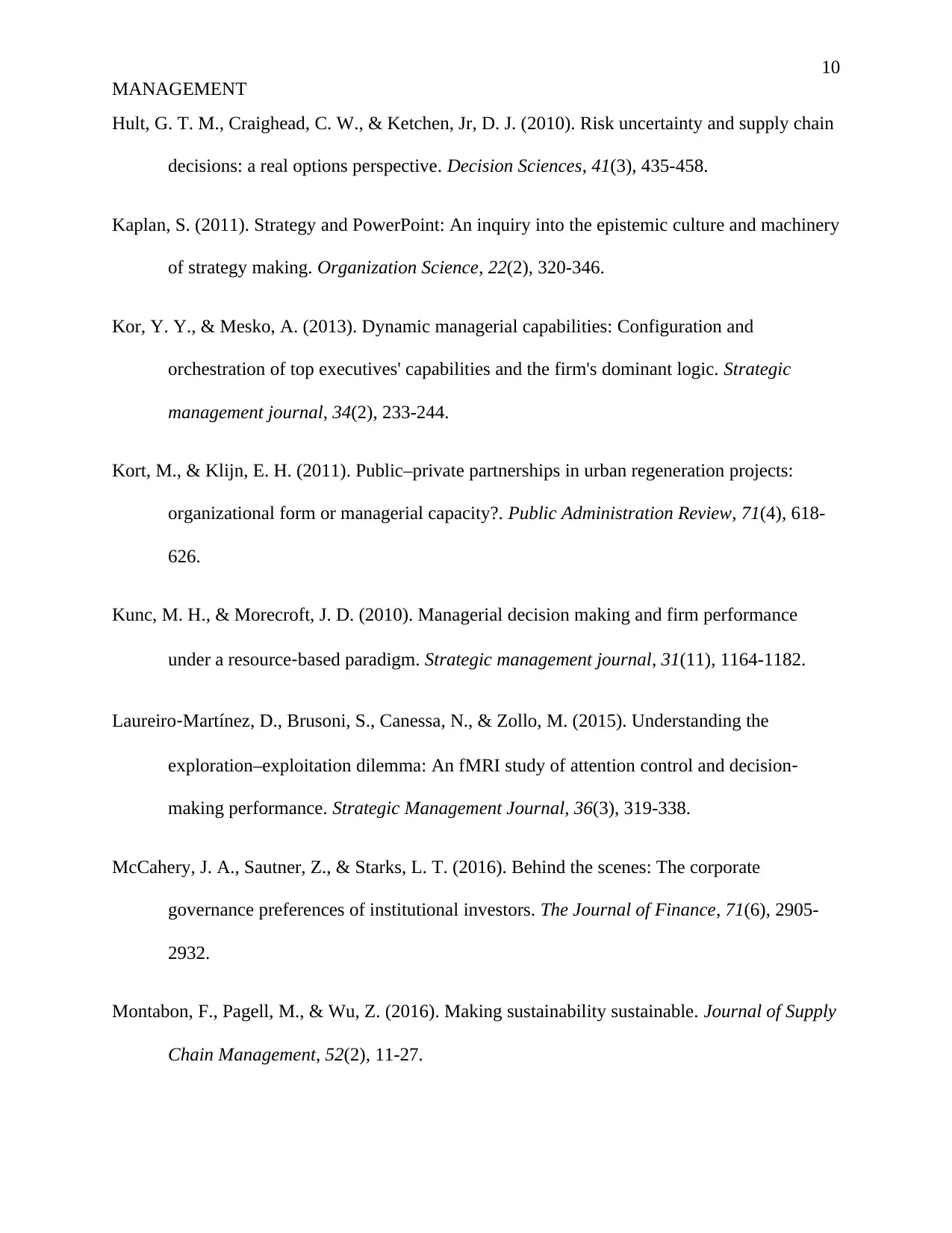
10
MANAGEMENT
Hult, G. T. M., Craighead, C. W., & Ketchen, Jr, D. J. (2010). Risk uncertainty and supply chain
decisions: a real options perspective. Decision Sciences, 41(3), 435-458.
Kaplan, S. (2011). Strategy and PowerPoint: An inquiry into the epistemic culture and machinery
of strategy making. Organization Science, 22(2), 320-346.
Kor, Y. Y., & Mesko, A. (2013). Dynamic managerial capabilities: Configuration and
orchestration of top executives' capabilities and the firm's dominant logic. Strategic
management journal, 34(2), 233-244.
Kort, M., & Klijn, E. H. (2011). Public–private partnerships in urban regeneration projects:
organizational form or managerial capacity?. Public Administration Review, 71(4), 618-
626.
Kunc, M. H., & Morecroft, J. D. (2010). Managerial decision making and firm performance
under a resource‐based paradigm. Strategic management journal, 31(11), 1164-1182.
Laureiro‐Martínez, D., Brusoni, S., Canessa, N., & Zollo, M. (2015). Understanding the
exploration–exploitation dilemma: An fMRI study of attention control and decision‐
making performance. Strategic Management Journal, 36(3), 319-338.
McCahery, J. A., Sautner, Z., & Starks, L. T. (2016). Behind the scenes: The corporate
governance preferences of institutional investors. The Journal of Finance, 71(6), 2905-
2932.
Montabon, F., Pagell, M., & Wu, Z. (2016). Making sustainability sustainable. Journal of Supply
Chain Management, 52(2), 11-27.
MANAGEMENT
Hult, G. T. M., Craighead, C. W., & Ketchen, Jr, D. J. (2010). Risk uncertainty and supply chain
decisions: a real options perspective. Decision Sciences, 41(3), 435-458.
Kaplan, S. (2011). Strategy and PowerPoint: An inquiry into the epistemic culture and machinery
of strategy making. Organization Science, 22(2), 320-346.
Kor, Y. Y., & Mesko, A. (2013). Dynamic managerial capabilities: Configuration and
orchestration of top executives' capabilities and the firm's dominant logic. Strategic
management journal, 34(2), 233-244.
Kort, M., & Klijn, E. H. (2011). Public–private partnerships in urban regeneration projects:
organizational form or managerial capacity?. Public Administration Review, 71(4), 618-
626.
Kunc, M. H., & Morecroft, J. D. (2010). Managerial decision making and firm performance
under a resource‐based paradigm. Strategic management journal, 31(11), 1164-1182.
Laureiro‐Martínez, D., Brusoni, S., Canessa, N., & Zollo, M. (2015). Understanding the
exploration–exploitation dilemma: An fMRI study of attention control and decision‐
making performance. Strategic Management Journal, 36(3), 319-338.
McCahery, J. A., Sautner, Z., & Starks, L. T. (2016). Behind the scenes: The corporate
governance preferences of institutional investors. The Journal of Finance, 71(6), 2905-
2932.
Montabon, F., Pagell, M., & Wu, Z. (2016). Making sustainability sustainable. Journal of Supply
Chain Management, 52(2), 11-27.
Paraphrase This Document
Need a fresh take? Get an instant paraphrase of this document with our AI Paraphraser
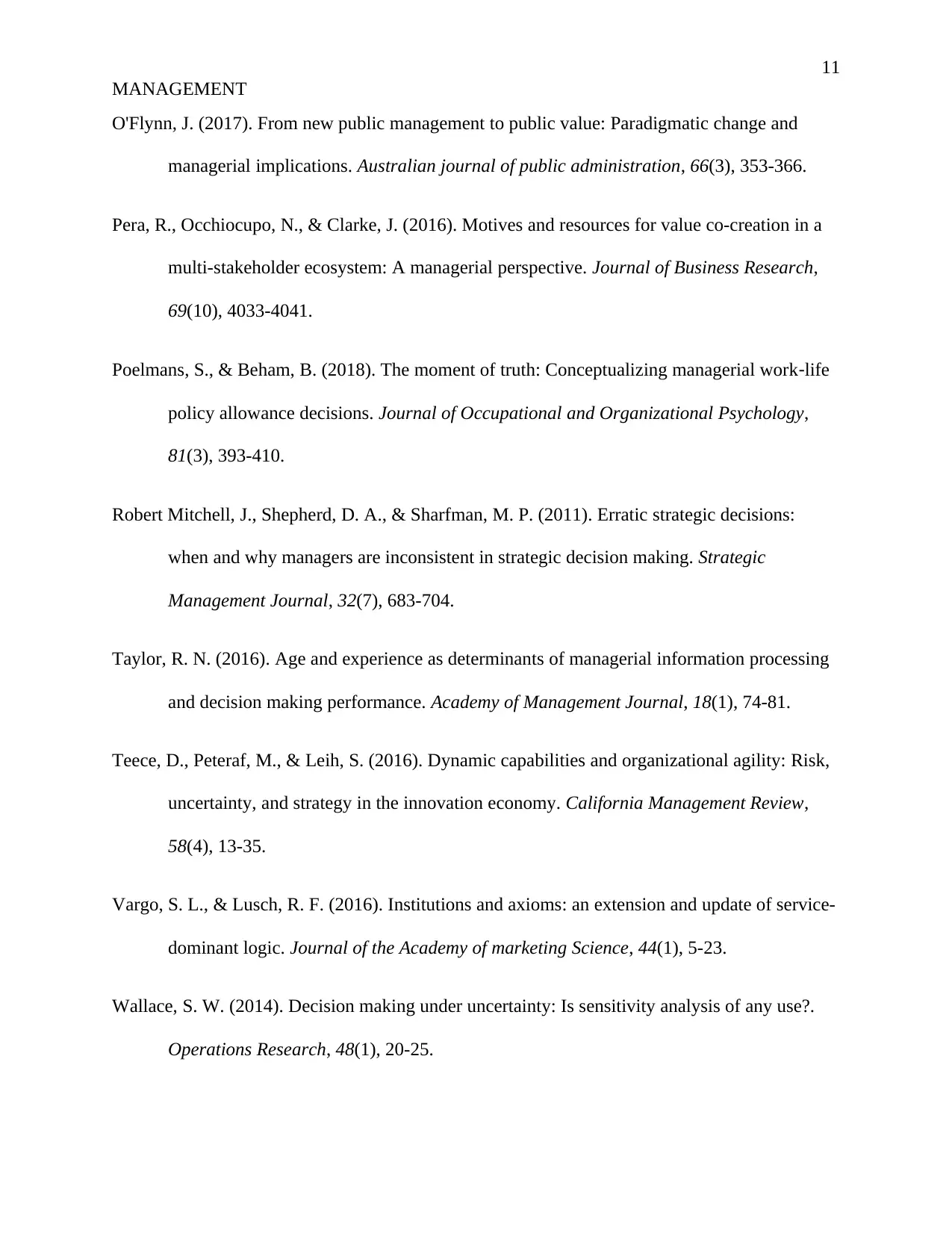
11
MANAGEMENT
O'Flynn, J. (2017). From new public management to public value: Paradigmatic change and
managerial implications. Australian journal of public administration, 66(3), 353-366.
Pera, R., Occhiocupo, N., & Clarke, J. (2016). Motives and resources for value co-creation in a
multi-stakeholder ecosystem: A managerial perspective. Journal of Business Research,
69(10), 4033-4041.
Poelmans, S., & Beham, B. (2018). The moment of truth: Conceptualizing managerial work‐life
policy allowance decisions. Journal of Occupational and Organizational Psychology,
81(3), 393-410.
Robert Mitchell, J., Shepherd, D. A., & Sharfman, M. P. (2011). Erratic strategic decisions:
when and why managers are inconsistent in strategic decision making. Strategic
Management Journal, 32(7), 683-704.
Taylor, R. N. (2016). Age and experience as determinants of managerial information processing
and decision making performance. Academy of Management Journal, 18(1), 74-81.
Teece, D., Peteraf, M., & Leih, S. (2016). Dynamic capabilities and organizational agility: Risk,
uncertainty, and strategy in the innovation economy. California Management Review,
58(4), 13-35.
Vargo, S. L., & Lusch, R. F. (2016). Institutions and axioms: an extension and update of service-
dominant logic. Journal of the Academy of marketing Science, 44(1), 5-23.
Wallace, S. W. (2014). Decision making under uncertainty: Is sensitivity analysis of any use?.
Operations Research, 48(1), 20-25.
MANAGEMENT
O'Flynn, J. (2017). From new public management to public value: Paradigmatic change and
managerial implications. Australian journal of public administration, 66(3), 353-366.
Pera, R., Occhiocupo, N., & Clarke, J. (2016). Motives and resources for value co-creation in a
multi-stakeholder ecosystem: A managerial perspective. Journal of Business Research,
69(10), 4033-4041.
Poelmans, S., & Beham, B. (2018). The moment of truth: Conceptualizing managerial work‐life
policy allowance decisions. Journal of Occupational and Organizational Psychology,
81(3), 393-410.
Robert Mitchell, J., Shepherd, D. A., & Sharfman, M. P. (2011). Erratic strategic decisions:
when and why managers are inconsistent in strategic decision making. Strategic
Management Journal, 32(7), 683-704.
Taylor, R. N. (2016). Age and experience as determinants of managerial information processing
and decision making performance. Academy of Management Journal, 18(1), 74-81.
Teece, D., Peteraf, M., & Leih, S. (2016). Dynamic capabilities and organizational agility: Risk,
uncertainty, and strategy in the innovation economy. California Management Review,
58(4), 13-35.
Vargo, S. L., & Lusch, R. F. (2016). Institutions and axioms: an extension and update of service-
dominant logic. Journal of the Academy of marketing Science, 44(1), 5-23.
Wallace, S. W. (2014). Decision making under uncertainty: Is sensitivity analysis of any use?.
Operations Research, 48(1), 20-25.
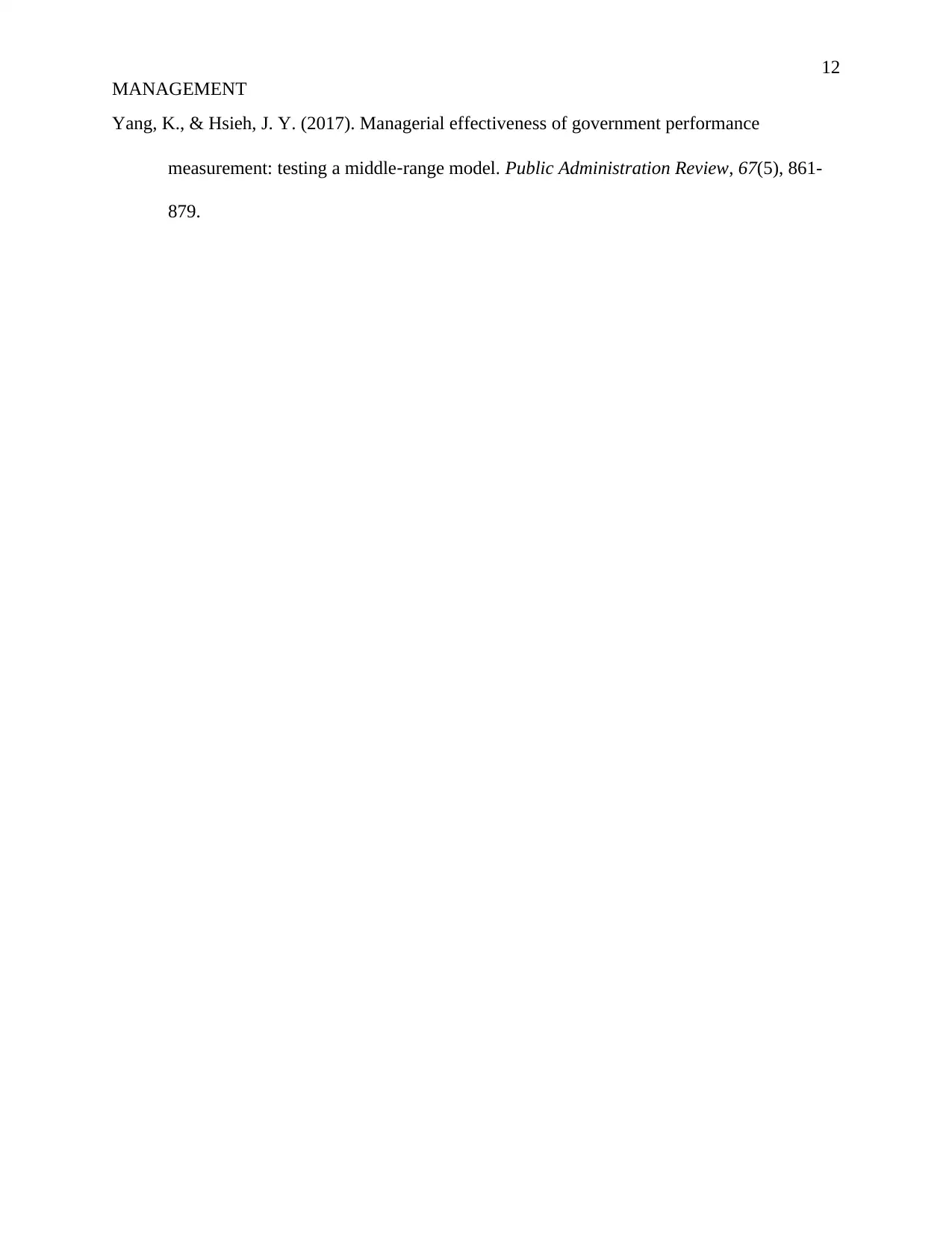
12
MANAGEMENT
Yang, K., & Hsieh, J. Y. (2017). Managerial effectiveness of government performance
measurement: testing a middle‐range model. Public Administration Review, 67(5), 861-
879.
MANAGEMENT
Yang, K., & Hsieh, J. Y. (2017). Managerial effectiveness of government performance
measurement: testing a middle‐range model. Public Administration Review, 67(5), 861-
879.
⊘ This is a preview!⊘
Do you want full access?
Subscribe today to unlock all pages.

Trusted by 1+ million students worldwide
1 out of 12
Related Documents
Your All-in-One AI-Powered Toolkit for Academic Success.
+13062052269
info@desklib.com
Available 24*7 on WhatsApp / Email
![[object Object]](/_next/static/media/star-bottom.7253800d.svg)
Unlock your academic potential
© 2024 | Zucol Services PVT LTD | All rights reserved.





